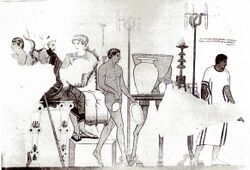Religion:Aita

Aita (Template:Lang-ett), also spelled Eita (Template:Lang-ett), is an epithet of the Etruscan chthonic fire god Śuri[1][2][3][4] as god of the underworld, roughly equivalent to the Greek god Hades (Template:Lang-grc-ion).[5]
Images
Aita is a relatively late addition to the Etruscan pantheon, appearing in iconography and in Etruscan text beginning in the 4th century BC, and is heavily influenced by his Greek counterpart, Hades.[6][7] Aita is pictured in only a few instances in Etruscan tomb painting, such as in the Golini Tomb from Orvieto and the tomb of Orcus II from Tarquinia.[8] In these tomb paintings, he is shown with his consort Persipnei (Template:Lang-ett), also spelled Phersipnai (Template:Lang-ett), the Etruscan equivalent to the Greek Persephone.[9]
Although Aita is very rarely depicted, he may appear enthroned and sometimes wears a wolf cap, borrowing a key attribute from the earlier Etruscan underworld wolf-deity, named Calu.[10] Other examples of Aita in Etruscan art depict his abduction of Persipnei. Aside from tomb painting, Aita may be identified in a few examples in other media, including on a 4th-century painted vase from Vulci, two 2nd century alabaster ash urns from Volterra, and a Red Figure 4th–3rd century Oinochoe.[11]
References
- ↑ Servius 380b, 11.785.
- ↑ De Grummond 2004, p. 359.
- ↑ National Etruscan Museum.
- ↑ Maras 2010.
- ↑ De Grummond 2006, p. 231.
- ↑ Jannot 2005, pp. 153–154.
- ↑ Helmut Rix, 1991. Etruskische Texte. Tübingen: Gunter Narr Verlag.
- ↑ De Grummond 2006, pp. 229–231.
- ↑ Jannot 2005, pp. 66–67, 153–154.
- ↑ Elliott 1995, pp. 17–33.
- ↑ Krauskopf 1988, pp. 394–399.
Bibliography
- De Grummond, Nancy Thomson (2004). "For the Mother and for the Daughter: Some Thoughts on Dedications from Etruria and Praeneste". Hesperia Supplements (The American School of Classical Studies at Athens) 33: 351–370. ISBN 9780876615331. https://www.jstor.org/stable/1354077.
- De Grummond, Nancy Thomson (2006). Etruscan Myth, Sacred History, and Legend. Philadelphia, PA: University of Pennsylvania Museum of Archaeology and Anthropology. ISBN 9781931707862.
- De Grummond, Nancy Thomson; Simon, Erika, eds (2006). The Religion of the Etruscans. Austin: University of Texas Press. ISBN 9780292782334. https://books.google.com/books?id=hQtbJyFCd40C.
- Script error: No such module "Harvc".
- Script error: No such module "Harvc".
- Script error: No such module "Harvc".
- Script error: No such module "Harvc".
- Elliott, John (1995-01-01). "The Etruscan Wolfman in Myth and Ritual". Etruscan Studies 2 (1): 17–33. doi:10.1515/etst.1995.2.1.17.
- Jannot, Jean-René (2005). Religion in Ancient Etruria. University of Wisconsin Press. ISBN 9780299208448.
- Lecce, Vittoria. "Novembre e il dio Suri - Il Nero Signore". Museo Nazionale Etrusco. https://www.museoetru.it/etru-a-casa-aiser/novembre-e-il-dio-suri.
- Lexicon Iconographicum Mythologiae Classicae. I–VIII. Zurich, Munich, Düsseldorf: Artemis & Winkler Verlag. 1981–1999. ISBN 3-7608-8751-1.
- Krauskopf, Ingrid (1988). "Aita/Calu". In LIMC. IV. pp. 394–399.
- Maras, Daniele F. (2010). "Suri. Il nero signore degli inferi". Archeo (305). http://www.archeo.it/rivista/2010/Luglio/suri-il-nero-signore-degli-inferi.
- Servius (380). Commentary on the Aeneid of Vergil. I–XII. Georgius Thilo. https://www.perseus.tufts.edu/hopper/text?doc=Perseus:text:1999.02.0053.
 |
